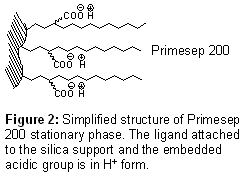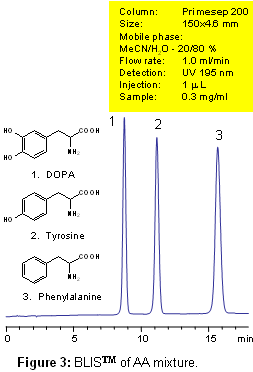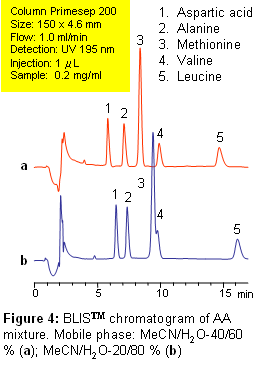BLISTM is a new separation technology for a-amino acids. Amino acids (AA) are very polar compounds and their separation typically is performed in ion-exchange mode. At a neutral pH, most naturally occurring and synthetic AA are essentially not charged if they have an equal amount of acidic and basic functional groups in the molecule. When using the ion-exchange mechanism, ion separation requires a high concentration of buffers in the mobile phase. Since AAs are not charged in non-buffered solutions, it requires an acid or a base to convert this zwitterionic molecule into a charged form (see Fig. 1).

This acid or base usually is a component of the mobile phase. However, if the stationary phase has embedded acidic or basic functional groups, it can provide the necessary ionization for zwitterions. The Primesep 200 column is a reverse phase column with embedded acidic functional groups (Fig. 2).

These groups, while in H+ form, provide an on-column acidic environment where the AA is positively charged and electrostatically interacts with a negatively charged surface. This interaction is strong, but it is reversible at the same time. The mobile phase contains neither buffers nor any other ionic additives except those that are provided by pure water in the mixture with acetonitrile (MeCN). We call this technique buffer-less ion separation, or BLIS for short. The simple condition, universal detection, and good chromatography make this technique convenient for separation of polar compounds (see Fig. 3). Primesep 200 is a reverse phase (RP) column resulting in a hydrophobic interaction and high selectivity, which can be controlled by the amount of MeCN in the mobile phase (see Fig. 4). For polar compounds, the amount of MeCN in the mobile phase produces little effect on retention. For hydrophobic compounds, the concentration of MeCN has the same effect on retention as in any other reverse phase separation (see Fig. 5). At a high organic concentration, the ionic interaction becomes a main component of the retention. At a very high organic concentration, the retention increases again due to HILIC interaction. This technique is also applicable to peptides and any other zwitterions. A column with a weaker embedded acidic group such as Primesep C will be more suitable in case of peptides. Low ion-strength modifiers such as acetic or formic acid can be used if necessary without significantly affecting the separation.





